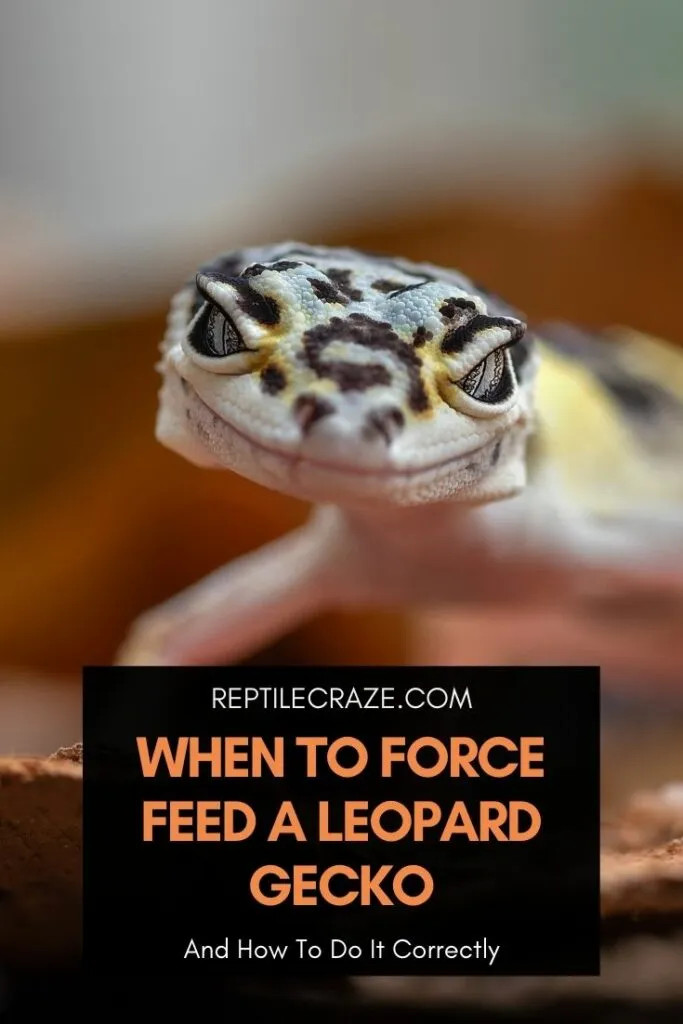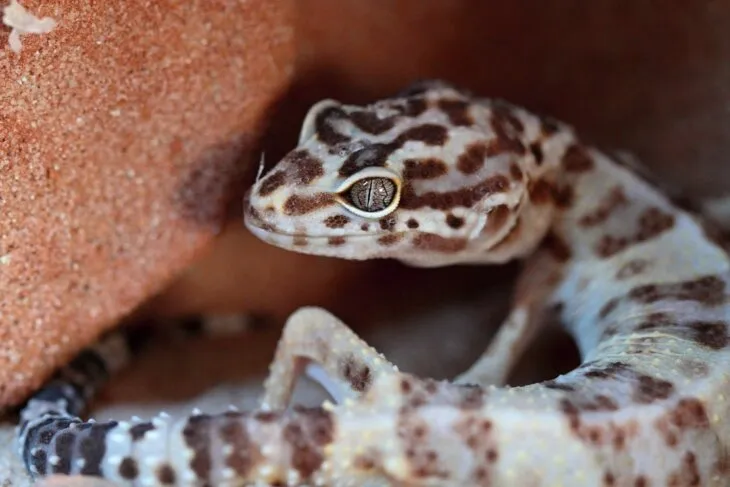
When your Leopard Gecko (Eublepharis macularius) stops eating or loses weight, it is really worrying. You might try offering different foods, or hand feeding. But how do you know when you should force-feed your Leopard Gecko?
Force-feeding should be a last resort. If your Leopard Gecko has refused to eat for more than a week, a vet may instruct you to force-feed. But you should not do it otherwise. Force-feeding can help to deliver nutrients to sick and underweight Leopard Geckos. But, it risks impaction and injury.
That is the basic information. Let’s explore more about how and when force-feeding might be necessary.
Table of Contents
Leopard Geckos May Need To Be Force-Fed When They Are Unwell
If your Leopard Gecko has been refusing meals, or is eating a little but losing weight, something could be wrong. After about 1 week of your Leopard Gecko not eating, we recommend that you call your vet.
Note: We show you 21 reasons why leopard geckos stop eating here. This could help before visiting a vet. We still recommend calling a vet to make sure your leo doesn’t have something serious.
Don’t worry too much, it is not certain that your Leopard Gecko is ill just because he or she did not eat for a week. Sometimes, Leopard Geckos stop eating. For example, around the time of egg-laying, or when in proximity to a potential mate.
Thanks to the fat stores in their tails, adult Leopard Geckos can survive for up to 2 weeks without any
But, this doesn’t mean you can assume that nothing is wrong if your Leopard Gecko stops eating. You definitely need to consult your vet before the situation escalates.
Your vet may recommend that you force-feed your Leopard Gecko. Unless the vet instructs you to force-feed, it is best not to.
There are plenty of risks to force-feeding and you could make your pet more ill by force-feeding when you don’t know what is wrong.
The Benefits Of Force-Feeding Leopard Geckos
Force-feeding can be used to help a Leopard Gecko eat
Even though your Leopard Gecko may need nutrition and energy from
In other cases, your Leopard Gecko may want to eat, but is unable to due to lethargy or injury. For example, they may be blind or unable to move around and hunt.
In this case force-feeding is more like hand-feeding in a very controlled way. We’ll learn more about the differences below.

The Dangers Of Force-Feeding Leopard Geckos
There are a number of dangers related to force-feeding. The first is physical injury to yourself or your Leopard Gecko.
Because you need to restrain your Leopard Gecko in your hand, there is a risk of applying too much pressure and causing a crush injury.
Also, you may accidentally mishandle or frighten your pet and cause him to drop his tail. This would be very bad news for an already unwell Leopard Gecko that desperately needs his energy reserves.
Other injuries can occur related to the mouth. First off, your Leopard Gecko may bite you. Also, you could injure their jaw by forcefully opening their mouth and pushing tongs,
This could occur even if you are trying to be gentle.
Beyond that, damage could be done internally. When restrained in your hand and having foodstuffs placed in his mouth, your Leopard Gecko cannot manipulate
You might cause him to swallow something too large, swallow an insect awkwardly, or simply eat more than his stomach can handle.
Inappropriate force-feeding could lead to choking, regurgitation, and impaction. If nothing else, force-feeding can cause stress and further illness.
Force-Feeding Is Different From Hand-Feeding
Force-feeding is different from hand-feeding. With hand-feeding, your aim is to offer
Hand-feeding is a great way to build trust between you and your pet. Hand-feeding can also be used to encourage a Leopard Gecko to eat if they haven’t been eating well.
However, when hand-feeding, you don’t restrain your Leopard Gecko. Also, you try to offer the
You can find out more about how to hand-feed Leopard Geckos in our guide here.
There Are Different Levels Of Force-Feeding
There are different levels of severity to force-feeding. How gently or forcefully you offer
Assist-Feeding
The least forceful type of force-feeding involves gently restraining your Leopard Gecko by holding them. You offer
This type of force-feeding is very similar to hand-feeding. The Leopard Gecko has a choice about whether to open his mouth and eat.
The main difference is that they are restrained and that you bring the
This gentle type of force-feeding is most suited to animals that want to eat, but are struggling to do it. For example, a blind or injured animal who needs a little extra help. This method is often referred to as assist-feeding.
Below is a good example of a gentle level of assist-feeding. The Leopard Gecko clearly has a choice of whether to bite onto and swallow the mealworm.
Force-Feeding
The next level is much riskier, because you are now forcing your Leopard Gecko to eat. Never do this unless a vet has specifically told you to and shown you how.
When force-feeding like this, you would hold your Leopard Gecko gently to restrain him. Then, you would stroke the side of their mouth, to trigger him to open it.
Then, you might place the pad of your thumb or finger at the sides of the mouth to hold it open.
After this, you would place
In this video, you can see how a vet restrains a Leopard Gecko and triggers it to open his mouth and keep it open.
Force-Feeding Via Intubation
Force-feeding by passing a tube down to a Leopard Gecko’s stomach is the most severe form of force-feeding and should only be done by veterinary professionals.
But, in cases where a 10% drop in body weight has been seen, this type of nutritional support can be lifesaving.
On occasion, a veterinary professional will teach animal care professionals how to do this. But, you should never try this yourself without a vet.
It requires specialist anatomical knowledge, as well as the use of medical equipment. This includes speculums, syringes, nutritional formulas, and tubing which must be passed directly down to the stomach.
What Food Do You Use To Force Feed Leopard Geckos?
Your vet will advise you on what
As always, choosing insects that are too large can cause choking or impaction. Ensure you choose an insect that is narrower than the distance between your Leopard Gecko’s eyes.
Larval feeders such as mealworms, silkworms, hornworms, black soldier fly larvae, and wax worms are much easier to use when force-feeding.
Crickets, grasshoppers, and roaches can be more difficult to grip and deliver safely into the mouth of your Leopard Gecko.
Also, larval feeders are higher in calories. If your Leopard Gecko is dropping weight or fighting an illness, he will likely need more calories.
However, in some cases, this is not accurate. For example, if your Leopard Gecko has stopped eating due to fatty liver disease. This is why it is essential to consult a vet, rather than try to provide nutritional support without medical guidance.
Offering Liquified
If your Leopard Gecko is not swallowing insects or has suffered drastic weight loss or dehydration, then liquid
Vets may offer a different type of liquid
Veterinary nutritional support is designed to deliver nutrients that are highly bio-available for use by the sick Leopard Gecko’s body.
If your Leopard Gecko needs acute medical care, don’t attempt to use slurry as a replacement for the advanced formulas that a vet can prescribe.
How To Make A Slurry For Force-Feeding Leopard Geckos
The safest way to create a slurry to force-feed your Leopard Gecko with is to make a smoothie out of their normal
This will not help your Leopard Gecko.
Select the insects that you want to feed your Leopard Gecko. Your vet will have told you what you should be feeding at this time. Most likely, you will use between 5-8 live feeder insects such as mealworms.
Coat the insects as usual with calcium and vitamin supplement. Then comes the unpleasant part. You need to mush them up with water, to make a sludgy liquid.
Many people use a pestle and mortar for this. You could use a mini-blender or blending stick. Ensure you create a fairly smooth mixture that you can drip from a syringe.
How To Use A Syringe To Force-Feed A Leopard Gecko
To deliver the slurry to your Leopard Gecko, you will need a syringe. The syringe barrel should never have a needle. But, you may wish to add a short length of soft flexi-tube to the tip of the syringe so it is smaller and softer.
It is important that you never put the syringe far into your Leopard Gecko’s mouth or down their throat. Also, never push down hard on the plunger to create a stream of slurry. You are likely to choke your Leopard Gecko.
What you want to do is place some drops of slurry on the side of your Leopard Gecko’s mouth. You aim to get them to lick it off. This is the gentle version of force-feeding, also known as assist-feeding.
In the video below, you can see the use of a syringe to gently offer liquid
If your vet has advised and demonstrated that you should go further, you can use the syringe to deliver a few drops of slurry inside your Leopard Gecko’s mouth. Allow him to swallow it freely.
In the video below you can see an example of this more forceful, but still careful, syringe feeding.
Never try to intubate your Leopard Gecko at home. Not even partially, by putting the syringe tip down to the back of the throat. This is a job for veterinary professionals and people trained by veterinary professionals.
- Eastern Rat Snake: Nature’s Pest Control and Fascinating Reptile - September 20, 2024
- Eastern Racer: The Fast and Agile Snake - September 19, 2024
- The Eastern Indigo Snake: The Majestic, Non-Venomous Hunter of the Southeast - September 18, 2024
